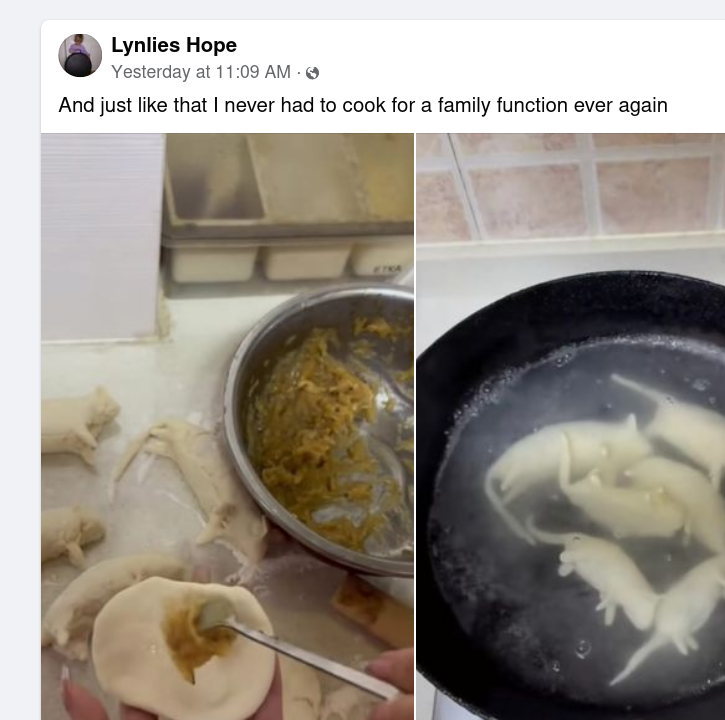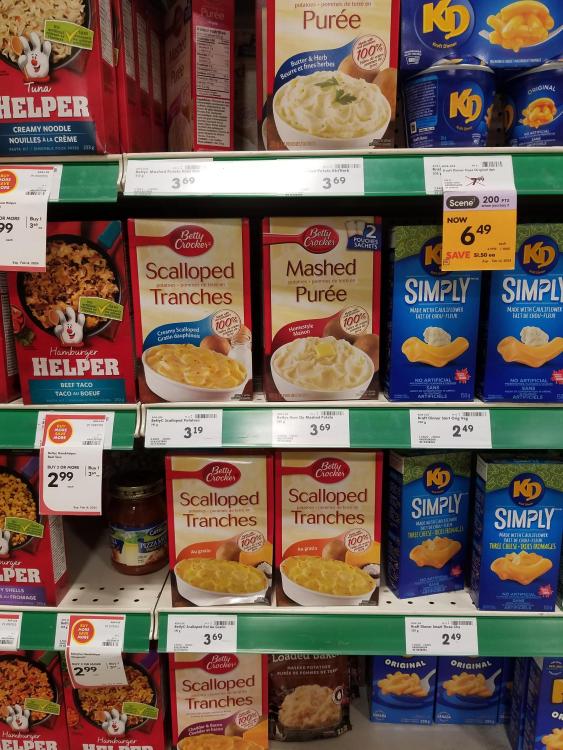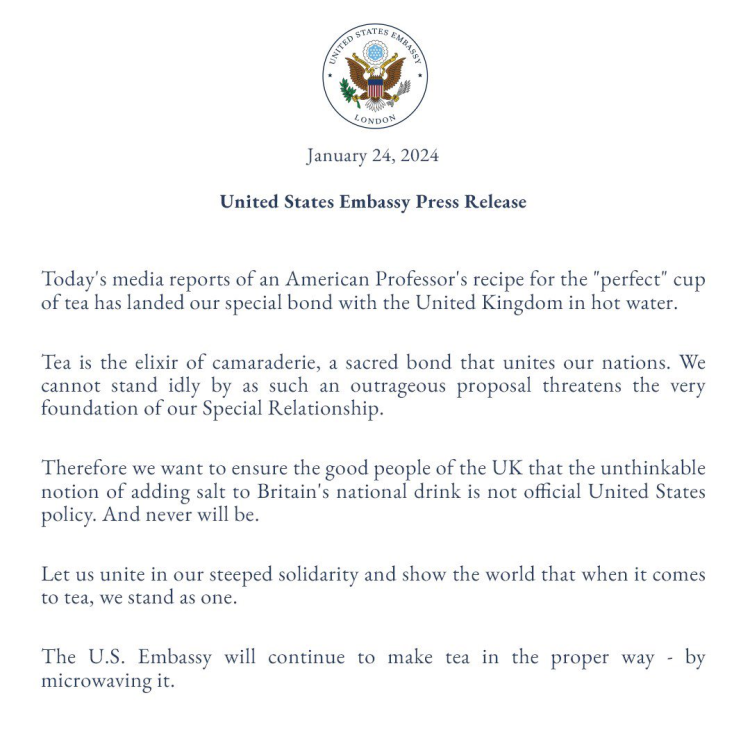-
Posts
6,339 -
Joined
-
Last visited
Content Type
Profiles
Forums
Store
Help Articles
Everything posted by chromedome
-
Just gonna leave this here... https://www.npr.org/sections/health-shots/2024/02/06/1228868005/purple-tomato-gmo-gardeners
-
I haven't had my hands on that one personally, but had taken note of it because of its very cool pull-out display. I have a really cheap Starfrit, which is fine for my usage on the whole, but irritating when I want to use it with a larger bowl. The pull-out display on the OXO would eliminate that issue.
-
This one currently affects Ontario, Quebec, Newfoundland and New Brunswick, but of course these can sometimes expand. The product is Rojo's 6-Layer Black Bean Dip, and like the corn salad just up-thread it's being recalled for Listeria (and is related to a US recall). https://recalls-rappels.canada.ca/en/alert-recall/rojo-s-brand-black-bean-6-layer-dip-recalled-due-listeria-monocytogenes?utm_source=gc-notify&utm_medium=email&utm_content=en&utm_campaign=hc-sc-rsa-22-23
-

Things Customers Have Said Which Made You Want to Roll Your Eyes
chromedome replied to a topic in Restaurant Life
At the restaurant where I worked my way through school, we served a "seafood medley" of sorts (it had a better name on the menu, but it's been 20 years and I don't remember it). This dish consisted of a lobster tail removed from the shell, which was then stuffed with lemon-scented arborio rice. The stuffed shell was topped with shrimp and scallops, the tail was cut into medallions and arranged around the shell, and it was served with a creamy sauce based on shrimp broth. All of this, to be clear, was explicitly spelled out on the menu. We had a customer one night explain that she loved seafood but had a shellfish allergy, and was it possible to get the seafood medley without shellfish? "Why of course," we grumbled in the kitchen. "Here's your $35 scoop of rice." (The server explained that no, that wasn't a possibility with this dish, and she eventually ordered something else.) -
Here's a much bigger one: "Mexican street corn" salads, sold under the President's Choice and Taylor Farms names, are being recalled for possible listeria. https://recalls-rappels.canada.ca/en/alert-recall/president-s-choice-brand-and-taylor-farms-brand-mexican-style-street-corn-salad-kits?utm_source=gc-notify&utm_medium=email&utm_content=en&utm_campaign=hc-sc-rsa-22-23
-
Okay, Ontario peeps, this is a small one but who knows, right? The summer sausages from Bauman's Country Meat Shop in Dobbinton are being recalled for listeria. Dunno if any of you live close enough that this would be a threat, but better safe than sorry. https://recalls-rappels.canada.ca/en/alert-recall/bauman-s-country-meat-shop-brand-summer-sausages-recalled-due-listeria-monocytogenes?utm_source=gc-notify&utm_medium=email&utm_content=en&utm_campaign=hc-sc-rsa-22-23
-
I'm late to the news, but saw a mention on another thread yesterday. I've had on-thread interactions/exchanges with a lot of eGers, but private conversations with only a relative few. Heidi was one of those. I always appreciated her good-humored (if often exasperated) recounting of her trials with her father and stepmother, and the various health issues and other incidental aggravations that come along in life. She'd have fit in well with my family, where that instinct to find humor in any given scenario is innate and unquenchable (my father joked from his literal deathbed). Having gathered from one of my comments that I'm a bit of a history/current affairs geek, she told me about her own family's history as Donauschwaben, ethnic Germans in what was by then Yugoslavia. The Nazis considered ethnic Germans everywhere to be citizens of the Reich, whether they would or no, and conscripted them accordingly. Between that, and the generally prevailing anti-German sentiment in the immediate postwar era, and the inevitable handful who embraced the opportunity to join Hitler's war machine, the Donauschwaben had targets on their backs after the war and were the victims of a straight-out genocide in Yugoslavia in the late 40s. It was an episode I hadn't previously been aware of, despite my broad reading, and was both fascinating and harrowing to learn about.
-
You can check on Facebook for a local Buy Nothing group page, and join/participate that way. I was a bit surprised that you can't just participate through the website, but (shrug) it's their party, they can force the app if they want to. I make a very deliberate practice of not installing any app unless I have an absolute need of it and there's no workaround, but there is a local group on Facebook so I've applied to it and will at least lurk for a while and see how active it is.
-
It must be said that for someone who posts relatively little, you have the whole "eG enabler" thing down cold.
-
It's genuine, from a Pizza Hut in Timmins, Ontario. Story here: https://northernontario.ctvnews.ca/northern-ont-pizza-shop-s-unforeseen-circumcisions-typo-goes-viral-1.6746886 The followup sign they posted (scroll through the article) makes it even better.
-
Regional nomenclature's fun, isn't it? Up here a "leg" is always the whole thing; the individual segments are thigh and drumstick.
-
-
I use salt at 2% of cabbage weight in my sauerkraut. I generally make a middlin' batch that half-fills a food-grade plastic bucket, and we already have lids with holes for airlocks because of my GF's sporadic winemaking hobby, so those are the easy option for me. I weight mine with a plate that leaves just a smidge of space around each side (I have a specific plate for that bucket) and set a mason jar full of water on top with a plastic screw-on lid, lest it tip into the brine at some point and a conventional ring/lid get rusted. C02 (or any other gas) would pass through a mesh with a 4mm grid, no?
-
Just a quick followup to note that talks have, for now, been broken off. As you would expect, there are some differences in how the rupture has been reported in Canada vs the UK. https://www.theguardian.com/business/2024/jan/26/uk-suspends-trade-talks-canada-no-progress-details-agriculture-markets https://www.cbc.ca/news/politics/canada-uk-trade-cheese-1.7094817 The Canadian government's official "take" on the whole hormones-in-beef topic can be found on this page (last updated in 2012): https://www.canada.ca/en/health-canada/services/drugs-health-products/veterinary-drugs/factsheets-faq/hormonal-growth-promoters.html
-
Okay, I looked in both stores today and they are definitely in the "side dishes" aisle in each case, though the rest of the aisle varies from one to the other. You can tell Ed to look for them sandwiched in between the Kraft Dinner, Hamburger Helper, etc. (at around eye height, too!). Here's how it looks at my local Sobeys: The brown bag barely visible at bottom/right/center is the Idahoan brand (clearly BC swings more weight in the bribery "shelf placement subsidy" sweepstakes).
-
-
I'm not really brand-loyal, so I'll use whatever's cheap on the day, but both Betty Crocker and Idahoan are available at Superstore and Sobeys IIRC. I've probably used both stores' store brands as well, though I can't guarantee it. They should be in the same aisle as other side dishes, but SS and Sobeys lay out their stores differently so I can't narrow it down more closely than that. I'll be in one and possibly both, later this afternoon, so I'll take a look specifically for the spudflakes* and report back. (*Another oddball use I hadn't mentioned is faux snow around Christmas decor, not recommended in humid climates)
-
I usually keep a box on hand for odd uses. Not typically to make up a portion of mashed per the instructions, though I'll do that occasionally. My hands are growing clumsier due to arthritis and occasionally I splash more milk into my mashed than I'd intended, and the flakes are a good way to restore the correct consistency. Instant mashed plus a cup of chicken or veg broth (or Better Than Bouillon, in a pinch) makes a quick potato soup on cold days. I scatter a light sprinkling of the flakes between the layers of my scalloped potatoes, to help thicken them, and potato flakes make an unusual but effective "breading" for fish (a nice alternative if you're serving/are a celiac sufferer).
-
I remember a cookbook I read years ago quoting a Nicaraguan as saying wryly that "for breakfast we have rice and beans, for lunch we have beans and rice, and for dinner we have gallo pinto."
-
This is more "agriculture" than "food science" per se, but we've veered into food production previously on this thread (and mods, I *did* look for a thread on agricultural innovations, because I thought I remembered one existing, but failed to find one). A reasonably rigorous life-cycle analysis of urban farming, with mixed results. More importantly, it sheds some light on how these operations can be refined depending on their individual goals. https://arstechnica.com/science/2024/01/urban-agricultures-carbon-footprint-can-be-worse-than-that-of-large-farms/













